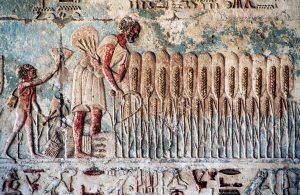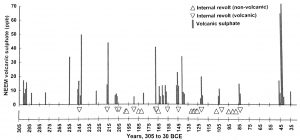What happened?
- The Ptolemaic Egyptian Kingdom (305-30 BCE) was the longest and last Egyptian dynasty, and was the wealthiest and most powerful successor state of Alexander the Great. The dynasty, however, also experienced periods of instability.
- These included bloody revolts by Egyptians against the elite ruling Greek and socioeconomic stress, which were exacerbated by extreme droughts at times when the Nile River failed to flood on its regular, annual cycle.
- Socioeconomic stress, in particular, is evidenced by increased hereditary land sales — indicating families couldn’t produce enough crop yield to pay taxes — and the issuance of priestly decrees, or official orders, to reinforce elite authority.

A scene depicting a harvest at the tomb of Petosiris, a high priest of Thoth, at Tuna el-Gebel, Egypt, from the Ptolemaic era (From De Agostini/Getty Images via St. Fleur, 2017).
How is this related to climate?
- For Ancient Egyptian society, prosperity was overwhelmingly tied to the annual cycle of Nile summer flooding.
- Until 20th century river damming, the summer flood (driven primarily by monsoon rainfall in the Ethiopian highlands) peaked from August to September and receded by the end of October, when crop sowing began. The flooding would irrigate the land and deposit nutrient-rich soil, which allowed for the cultivation of crops.
- In Ptolemaic Egypt, several instances of extreme drought and Nile flooding suppression were caused by a series of explosive volcanic eruptions. The volcanic eruptions sent aerosols into the atmosphere, which led to falling temperatures and a reduction in evaporation from oceans and other large bodies of water. This impacted the African monsoon and interrupted the seasonal cycle of flooding in the Nile Basin.
- Evidence for the relationship between volcanic eruptions and droughts came from climate model output, sulphate and ash deposits in ice cores from Greenland and Antarctica, measurements from the Islamic Nilometer (a structure for measuring Nile water level and clarity during the annual flood season), and ancient Egyptian writings.
- The timing of these volcanic eruptions and subsequent droughts are associated with several onsets of social and economic unrest. Failure of the Nile River to flood served as a trigger for revolt against a backdrop of other stressors in Ptolemaic Egypt, such as ethnic tensions between Egyptians and Greek elites, growing demographic and fiscal pressures, burdensome state taxation, and increasing demand for wheat.
- The absence of Nile flooding often coincided with harvest failure, famine, mortality, and political instability.
- Nile flood failure also constrained interstate conflict, as societies experiencing internal instability are less able to engage in outward conflict. In this case, flood failure coincided with the cessation of Ptolemaic state conflict with the rivaling Seleucid Empire.
- While not the only source of instability in Ptolemaic Egypt, Nile flood failure helps to contextualize the formerly poorly understood revolts of the time and patterns of Ptolemaic military mobilization.

A graph of volcanic sulphate (gray columns) from Greenland ice cores, indicating volcanic eruptions, with historical revolts superimposed in triangles. Triangles pointed up are not associated with volcanic eruptions, while triangles pointed down are. The graph shows the possible relationship between volcanic eruptions and revolts (from Manning and Ludlow, 2016, p. 167).
Further exploration
- Presently, we are in a relatively quiet volcanic period, but 70% of the world’s population relies on monsoon-dependent agricultural systems, similar to those used in Ptolemaic Egypt. These findings of the relationship between the patterns of failed flooding and droughts due to disrupted monsoon systems as a result of volcanic eruptions may be a warning of what a volcanically active future may look like.
References and additional resources
- Manning, J. G., et al. “Volcanic Suppression of Nile Summer Flooding Triggers Revolt and Constrains Interstate Conflict in Ancient Egypt.” Nature Communications, vol. 8, no. 1, 2017, pp. 1–9. DOI: 10.1038/s41467-017-00957-y.
- Manning, J. G., and Ludlow, F. “Revolts under the Ptolemies : A Paleoclimatological Perspective.” Revolt and Resistance in the Ancient Classical World and the Near East: In the Crucible of Empire, edited by Collins, J. J. and Manning, J. G. Brill, 2016.
- Mark, J. J. “Ancient Egyptian Agriculture.” Ancient History Encyclopedia. 2017. https://www.ancient.eu/article/997/ancient-egyptian-agriculture/.
- Mayer, J. and Young, L. “The Art And History Shaped By Volcanic Winters.” Science Friday. 2019. https://www.sciencefriday.com/articles/the-art-and-history-shaped-by-volcanic-winters/.
- McConnell, J. R., et al. “Extreme Climate after Massive Eruption of Alaska’s Okmok Volcano in 43 BCE and Effects on the Late Roman Republic and Ptolemaic Kingdom.” Proceedings of the National Academy of Sciences, vol. 117, no. 27, 2020, pp. 15443–49. DOI: 10.1073/pnas.2002722117.
- St. Fleur, N. “Volcanoes Helped Violent Revolts Erupt in Ancient Egypt.” The New York Times. 2017. https://www.nytimes.com/2017/10/17/science/volcanoes-ancient-egypt-revolts.html.
